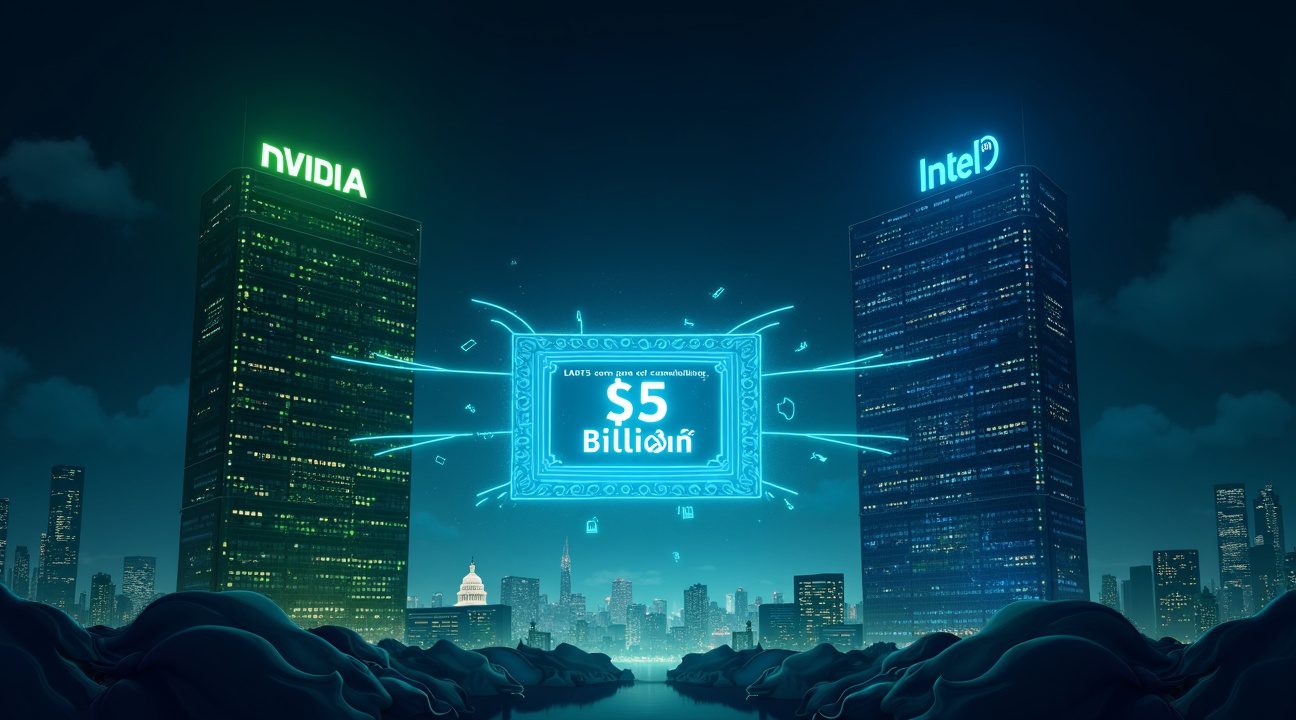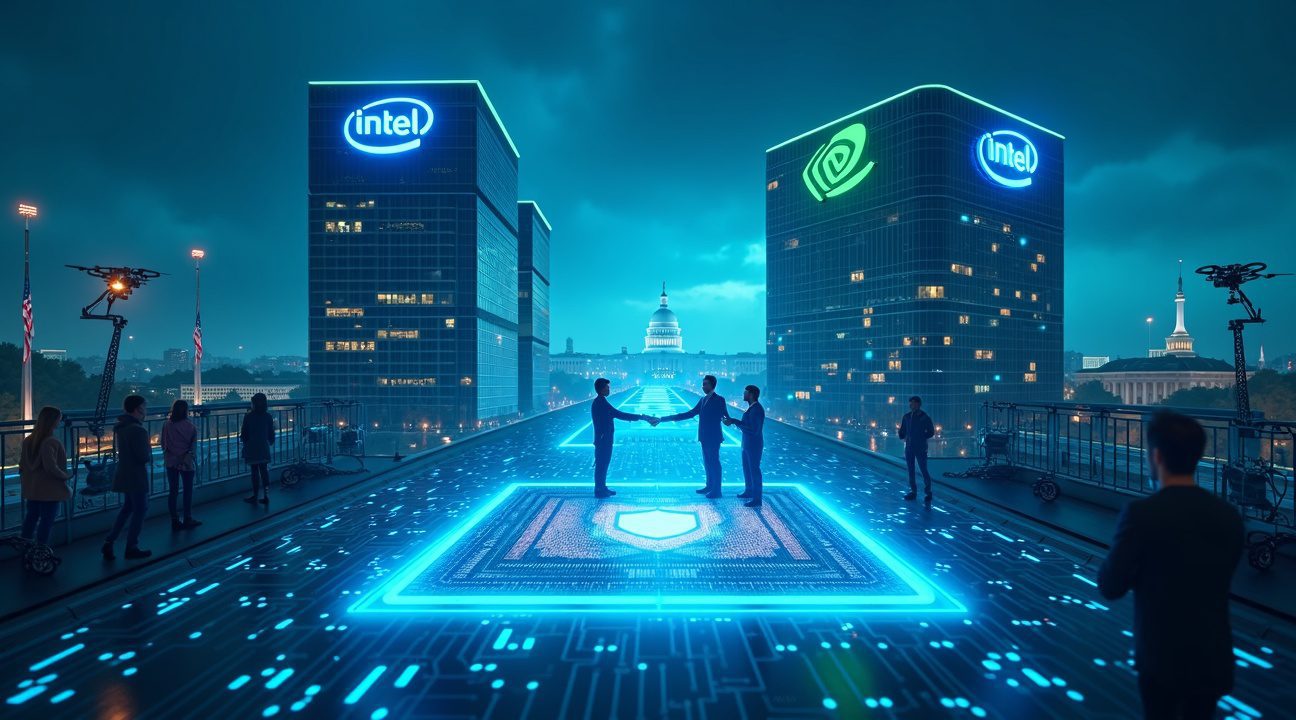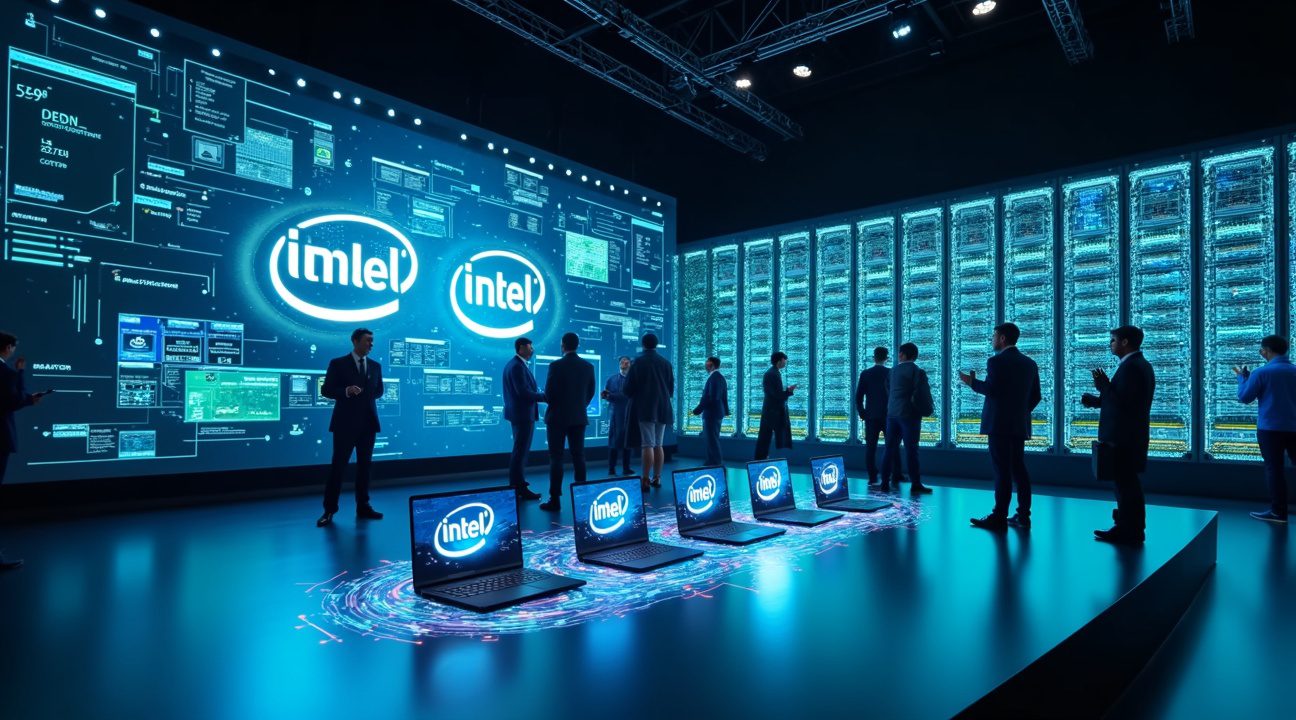Nvidia announced a revolutionary $5 billion investment in Intel’s common stock at $23.28 per share, creating one of the largest cross-company investments in semiconductor industry history. This strategic partnership goes beyond financial investment to include collaborative development of AI infrastructure and next-generation PC products, signaling a significant shift in how major chip companies approach competitive relationships.
Key Takeaways
- Nvidia’s $5 billion equity investment in Intel at $23.28 per share represents a substantial capital injection that drove Intel stock up 18% in pre-market trading.
- The partnership focuses on co-developing AI-enabled PCs and data center infrastructure by integrating Nvidia’s GPU technology with Intel’s CPU expertise.
- Manufacturing operations remain largely unchanged, with TSMC continuing as the primary production partner for advanced chips, while Intel may handle selective packaging operations.
- The deal developed independently through private sector negotiations without direct government involvement, though it aligns with U.S. strategic objectives for domestic semiconductor capabilities.
- Both companies will maintain existing partnerships and competitive relationships while exploring collaborative opportunities in AI-driven computing markets.
Nvidia Announces $5 Billion Intel Investment at $23.28 Per Share
Nvidia has announced a substantial $5 billion investment in Intel’s common stock, purchasing shares at $23.28 each. This acquisition represents one of the most significant cross-company investments in the semiconductor industry in recent years, signaling a potential shift in how major chip companies approach competitive relationships.
The equity purchase is structured as a direct investment in Intel’s common stock, giving Nvidia a meaningful stake in its longtime competitor. At $23.28 per share, the investment reflects current market valuations while providing Intel with substantial capital injection during a period of intense industry competition. This price point suggests Nvidia sees significant value in Intel’s current position and future prospects.
Regulatory Hurdles and Approval Process
The investment faces several regulatory requirements before completion. The deal must satisfy customary closing conditions and undergo regulatory review, including compliance with the Hart-Scott-Rodino Antitrust Improvements Act of 1976. This federal legislation requires companies to notify antitrust authorities before completing large mergers or acquisitions that exceed certain thresholds.
Given the size and nature of this investment, regulatory scrutiny will likely focus on several key areas:
- Potential market concentration in the semiconductor industry
- Impact on competition between the two chip giants
- Effects on pricing and innovation in graphics processing and CPU markets
- Implications for supply chain dynamics and customer relationships
The Hart-Scott-Rodino review process typically takes 30 days, though complex cases can extend significantly longer. Regulators will examine whether this investment could reduce competition or create unfair advantages in various chip market segments. The approval timeline could affect when Nvidia actually completes the purchase and begins exercising any shareholder rights.
This investment marks a departure from traditional industry relationships, where companies like Nvidia and Intel typically compete rather than collaborate through equity stakes. The announcement comes as both companies face increasing pressure from emerging technologies, changing market demands, and growing competition from companies like AMD and newer entrants in artificial intelligence processing.
The $5 billion figure represents significant capital deployment for Nvidia, even given its recent market valuation growth. This investment could provide Intel with resources to accelerate research and development efforts while giving Nvidia potential influence over Intel’s strategic direction. The partnership implications extend beyond simple financial investment, potentially reshaping how these semiconductor leaders approach future market opportunities and technological collaborations.

Intel Stock Surges 18% as Market Reacts to Partnership News
Intel shares jumped by as much as 18% in pre-market trading following NVIDIA’s announcement, demonstrating strong investor confidence in the partnership’s potential. I observed this surge as one of the most significant single-day movements for Intel stock in recent months, reflecting market enthusiasm for the collaboration between these semiconductor giants.
The market reaction reveals broader confidence in Intel’s strategic positioning as NVIDIA continues expanding its dominance in the AI chip sector. Analysts project that by late 2026, NVIDIA may generate more quarterly revenue than Intel’s entire annual revenue, highlighting the dramatic market shifts occurring within the semiconductor industry. This projection underscores why Intel’s partnership with NVIDIA carries such significant weight for investors.
This announcement arrives alongside other major developments in Intel’s financial landscape. The U.S. government recently acquired a 10% stake in Intel, while SoftBank invested $2 billion in the company last month. These investments signal coordinated efforts to strengthen Intel’s position as a critical component of America’s semiconductor infrastructure.
Strategic Implications for U.S. Semiconductor Independence
The partnership aligns with broader U.S. industrial policy objectives focused on reducing dependence on East Asian foundries, particularly TSMC in Taiwan. Government officials have emphasized the importance of building domestic semiconductor manufacturing capabilities, making Intel’s collaboration with NVIDIA a cornerstone of this strategic initiative.
Market analysts point to several key factors driving investor optimism:
- Enhanced manufacturing capabilities through shared expertise and resources
- Reduced reliance on foreign semiconductor production facilities
- Strengthened competitive position against international rivals
- Access to NVIDIA’s advanced AI chip technologies and market insights
The semiconductor supply chain has become a critical national security concern, with major tech partnerships increasingly viewed through the lens of geopolitical strategy. Intel’s stock surge reflects investor recognition that this collaboration positions the company as a key beneficiary of U.S. efforts to reshore semiconductor production.
Financial markets have responded positively to Intel’s recent string of partnerships and investments, with the 18% surge representing renewed confidence in the company’s long-term prospects. The partnership with NVIDIA, combined with government backing and international investment, creates a foundation for Intel to compete more effectively in the rapidly evolving semiconductor landscape while supporting broader U.S. technological independence goals.
Companies Will Co-Develop AI Infrastructure and Next-Generation PC Products
The partnership between Nvidia and Intel centers on collaborative product development rather than manufacturing relationships. This alliance focuses specifically on AI infrastructure solutions and cutting-edge personal computing devices that leverage both companies’ core strengths.
Intel will integrate Nvidia’s advanced graphics technology directly into their upcoming PC chip designs, creating hybrid processors that combine Intel’s CPU expertise with Nvidia’s GPU capabilities. This integration promises to deliver enhanced AI processing power for consumer devices while maintaining the performance standards both companies are known for.
Strategic Focus Areas and Implementation
The collaboration targets several key market segments that represent significant growth opportunities:
- AI-enabled personal computers that can handle complex machine learning tasks locally
- Next-generation data center products designed for enterprise AI workloads
- Integrated solutions combining Nvidia graphics with Intel’s established CPU platforms
- Advanced infrastructure components optimized for AI processing demands
Nvidia will simultaneously utilize select Intel processors to meet growing data center demand, creating a symbiotic relationship that benefits both companies’ product portfolios. This arrangement allows Nvidia to access Intel’s proven processor technology while Intel gains access to industry-leading graphics capabilities.
The partnership deliberately excludes Intel’s foundry operations, maintaining clear boundaries between product collaboration and manufacturing services. Intel’s foundry business will continue operating with external partners including TSMC for advanced chip production, though some packaging operations may still occur at Intel facilities. This separation ensures that Nvidia’s growth trajectory remains independent of Intel’s manufacturing capacity constraints.
Both companies recognize that AI-enabled computing represents the future of personal and enterprise technology. The collaboration allows them to combine Intel’s CPU architecture expertise with Nvidia’s graphics processing leadership, creating products that neither company could develop as effectively alone. This strategic alignment positions both firms to compete more effectively against other major tech partnerships in the rapidly evolving AI infrastructure market.
The initial product launches from this partnership will likely appear in high-performance PC segments before expanding into broader consumer markets. Data center applications will follow a parallel development track, focusing on enterprise customers who require powerful AI processing capabilities integrated seamlessly with traditional computing infrastructure.

Manufacturing Strategy Remains Unchanged Despite Partnership
The landmark deal between Nvidia and Intel doesn’t signal a dramatic shift in manufacturing operations for either company. I observe that both firms plan to maintain their existing production strategies while exploring selective collaboration opportunities that enhance their competitive positions.
TSMC Continues as Primary Manufacturing Partner
Most Nvidia-Intel products will continue relying on TSMC for advanced process nodes, particularly for cutting-edge GPU architectures that demand the most sophisticated semiconductor manufacturing capabilities. This decision reflects TSMC’s established leadership in producing chips at 3nm and below, where precision and yield rates remain critical for high-performance computing applications.
Intel’s facilities may handle packaging operations as Intel Foundry improves its production yields and capabilities. This arrangement allows both companies to benefit from Intel’s domestic manufacturing capacity while preserving access to TSMC’s advanced node expertise. The strategy represents a balanced approach that doesn’t disrupt existing supply chains while creating new opportunities for collaboration.
Nvidia’s ongoing collaborations with ARM for CPUs in robotics and other emerging markets will continue operating in parallel with this new Intel partnership. The company’s expansion strategy treats the Intel relationship as complementary rather than a replacement for existing alliances. This approach ensures Nvidia maintains flexibility across multiple product lines while strengthening its position in AI-driven applications.
The industry significance stems from both companies leveraging their complementary strengths rather than attempting to replicate each other’s capabilities. Nvidia’s leadership in AI GPUs pairs naturally with Intel’s CPU expertise, creating opportunities for integrated solutions that neither company could develop independently. This collaboration model represents a mature approach to partnership that recognizes each firm’s core competencies.
Manufacturing flexibility remains a key consideration as both companies adapt to rapidly changing market demands. The evolving technology landscape requires partners who can scale production efficiently while maintaining quality standards across diverse product categories.
Intel Foundry’s role in this partnership will likely expand gradually as the division demonstrates improved capabilities and competitive pricing. The measured approach allows both companies to test collaboration models without disrupting their primary manufacturing relationships or compromising product roadmap timelines that customers depend on for planning purposes.

Deal Emerges Independently of Government Involvement
Both companies’ leadership made it clear that this groundbreaking partnership developed through private sector negotiations, without direct White House intervention. The CEOs of Intel and NVIDIA emphasized their independent decision-making process, distinguishing this collaboration from government-mandated initiatives that have shaped other recent industry moves.
Strategic Alignment Beyond Direct Control
The timing couldn’t be more significant for U.S. national security priorities. This partnership directly supports domestic semiconductor production capabilities at a critical moment when China continues advancing its chip manufacturing infrastructure. Intel and NVIDIA’s collaboration strengthens America’s position in the global semiconductor race, creating a powerful alliance that enhances both companies’ competitive advantages.
The U.S. government’s recent acquisition of a 10% stake in Intel represents an unprecedented move for a technology company of this magnitude. This unusual step reflects the administration’s commitment to supporting critical chip sector infrastructure, even as private companies like NVIDIA maintain their independence in strategic decisions.
Private Initiative in Policy-Supportive Environment
While the partnership operates as a private sector initiative, it unfolds within a landscape of active U.S. industrial policy support. The administration’s broader trade policy pressure and substantial investments in domestic chip capabilities create favorable conditions for such collaborations. This environment encourages partnerships that align with national security objectives without requiring direct government orchestration.
The deal represents how private companies can advance strategic national interests while pursuing their own business objectives. Intel’s manufacturing expertise combined with NVIDIA’s AI and graphics processing leadership creates synergies that benefit both commercial markets and defense applications. Their collaboration addresses supply chain vulnerabilities that have concerned policymakers across multiple administrations.
This partnership also reflects lessons learned from recent supply chain disruptions and geopolitical tensions. Companies recognize that strategic partnerships can provide stability and competitive advantages in an increasingly complex global marketplace. The semiconductor industry’s critical importance to everything from automobiles to artificial intelligence makes such alliances particularly valuable.
The broader implications extend beyond immediate business benefits. This collaboration demonstrates how American technology companies can work together to maintain global leadership in critical technologies. Their combined resources and expertise position them to compete more effectively against international competitors while supporting domestic manufacturing capabilities that strengthen national security infrastructure.

Partnership Expected to Drive Innovation in AI-Enabled Computing
The strategic collaboration between Nvidia and Intel signals a transformative approach to AI-enabled computing across multiple market segments. This partnership leverages Nvidia’s GPU expertise alongside Intel’s CPU dominance to create enhanced solutions for both consumer and enterprise applications. The combination addresses growing market demands for sophisticated artificial intelligence capabilities in personal computers and data center environments.
Consumer and Enterprise Market Positioning
The alliance positions both companies to capture expanding opportunities in AI-enabled PCs, where consumers increasingly expect intelligent features and enhanced performance. Intel’s CPU architecture combined with Nvidia GPUs creates a powerful foundation for next-generation computing experiences. Enterprise markets benefit from this collaboration through improved data center AI solutions that can handle complex workloads more efficiently.
Modern businesses require computing infrastructure that can adapt to artificial intelligence demands while maintaining reliability and cost-effectiveness. The partnership enables development of integrated systems that optimize both processing power and energy efficiency. Companies exploring tech innovations will find these collaborative solutions particularly valuable for AI-driven applications.
Strategic Integration Without Disruption
The collaboration allows both companies to maintain their existing partnerships while exploring new technological frontiers together. Intel continues its relationships with other GPU manufacturers, while Nvidia preserves its connections with alternative CPU providers. This approach minimizes market disruption while maximizing innovation potential.
The integration strategy focuses on complementary strengths rather than exclusive arrangements. Intel’s manufacturing capabilities and CPU expertise merge with Nvidia’s AI acceleration technology to create solutions neither company could develop independently. Data center operators benefit from optimized hardware combinations that deliver superior performance for machine learning and artificial intelligence workloads.
Consumer markets see immediate benefits through enhanced AI PC performance, where integrated solutions provide smoother experiences for demanding applications. Gaming enthusiasts, content creators, and professionals working with AI-powered software gain access to more responsive and capable systems. The partnership’s focus on innovation ensures continuous improvement in processing capabilities across diverse use cases.
Future technology demands require adaptive approaches that can scale with emerging artificial intelligence requirements. The collaboration establishes a framework for ongoing development that addresses both current needs and anticipated market evolution. Nvidia’s market position combined with Intel’s established infrastructure creates substantial opportunities for breakthrough innovations.
Enterprise adoption of AI-enabled computing accelerates when hardware solutions offer clear performance advantages and reliable integration. The partnership delivers precisely these benefits through carefully coordinated development efforts that prioritize practical implementation over theoretical capabilities. Data center operators can implement these solutions with confidence, knowing both companies support the integrated approach.
The strategic positioning recognizes that artificial intelligence computing represents more than a temporary trend—it’s becoming fundamental to modern technology infrastructure. Consumer expectations continue evolving as AI capabilities become standard features rather than premium additions. The collaboration ensures both companies remain competitive in this rapidly developing landscape.
Market opportunities expand when partnerships create synergies that individual companies cannot achieve alone. This collaboration demonstrates how strategic alliances can drive innovation while preserving competitive flexibility. The approach suggests similar partnership opportunities may emerge across the technology sector as companies seek complementary capabilities.
The focus on AI-enabled computing positions both companies for sustained growth as artificial intelligence becomes increasingly integral to personal and professional computing environments. Data center AI products benefit from optimized hardware combinations that maximize performance while controlling costs. Consumer AI PCs gain enhanced capabilities that make advanced features accessible to broader audiences.
Innovation acceleration occurs when established companies combine their expertise to address emerging market demands. The partnership creates development pathways that neither Intel nor Nvidia could pursue independently, resulting in solutions that advance the entire industry. This collaborative approach sets precedents for future technology development across multiple sectors.

Sources:
Bloomberg Television, “Nvidia Invests $5 Billion in Intel to Co-Design Chips for PCs and Data Centers”
CNBC Television, “Nvidia CEO: Delighted to work with Intel in ‘great partnership'”
NVIDIA Newsroom, “NVIDIA and Intel to Develop AI Infrastructure and Personal Computing Products”


